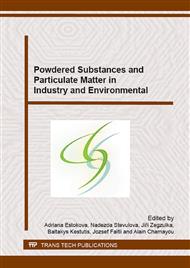[1]
A. Luptakova, E. Macingova, K. Apiariova, The selective precipitation of metals by bacterially produced hydrogen sulphide, Acta Metallurgica Slovaca 1 (2008) 149-154.
Google Scholar
[2]
D.K. Nordstrom, C.N. Alpers, Geochemistry of acid mine waters, The Environmental Geochemistry of Mineral Deposits, Part A, Processes, Methods, and Health Issues, Society of Economic Geologists, G.S. Plumlee and M.J. Logsdon (Eds. ), Rev. Econ. Geol. 6A (1999).
DOI: 10.5382/rev.06.06
Google Scholar
[3]
D-S. Stefan, J. Frederick van Staden, E. Vasile, O-R. Vasile, M. Dancila, Influence of sulfate and nitrate uptake from aqueous solutions on surface exchange, Comptes Rendus Chimie 17 (2014) 738-745. DOI: 10. 1016/j. crci. 2014. 01. 005.
DOI: 10.1016/j.crci.2014.01.005
Google Scholar
[4]
J.M. Bigham, U. Schwertmann , S.J. Traina, R.L. Winland, M. Wolf, Schwertmannite and the chemical modeling of iron in acid sulfate waters, Geochim. Cosmochim. Acta 60 (1996) 2111-2121. DOI: 10. 1016/0016-7037(96)00091-9.
DOI: 10.1016/0016-7037(96)00091-9
Google Scholar
[5]
E. Singovszka, M. Balintova, Pollution and potential ecological risk assessment of heavy metals in the Smolnik creek (Slovakia), Chem. Eng. Trans. 39 (2014) 1759-1764. DOI: 10. 3303/CET1439294.
Google Scholar
[6]
M. Kusnierova, M. Prascakova, A.K. Nowak, K. Gorazda, Z. Wzorek, 2014, Biogenic catalysis in sulphide minerals´ weathering processes and acid mine drainage genesis, Acta Biochimica Polonica 61 (2014) 33-39.
DOI: 10.18388/abp.2014_1920
Google Scholar
[7]
J. Skousen, A. Rose, G. Geidel, J. Foreman, R. Evans, W. Hellier, 1998. A handbook of technologies for avoidance and remediation of acid mine drainage. Acid Drainage Technology Initiative (ADTI), National Mine Land Reclamation Center, West Virginia University, Morgantown, WV, 1999, p.131.
DOI: 10.21000/jasmr05011100
Google Scholar
[8]
Q. Sun, L.M. McDonald, J.G. Skousen, Effects of armoring on limestone neutralization of AMD, West Virginia Surface Mine Drainage Task Force Symposium, Morgantown, WV, (2000) 93-102.
Google Scholar
[9]
B.B. Faulkner, J.G. Skousen, Treatment of acid mine drainage by passive treatment systems, International Land Reclamation and Mine Drainage Conference, Pittsburgh, PA. (1994) 250-256.
DOI: 10.21000/jasmr94020250
Google Scholar
[10]
A.D. Karathanasis, Y.L. Thompson, Mineralogy of iron precipitates in a constructed acid mine drainage wetland, Soil Sci. Soc. Am. J. 59 (1995) 1773-1781. DOI: 10. 2136/sssaj1995. 03615995005900060039x.
DOI: 10.2136/sssaj1995.03615995005900060039x
Google Scholar
[11]
M. Balintova, A. Petrilakova, Study of pH influence on selective precipitation of heavy metals from acid mine drainage, Chem. Eng. Trans. 25 (2011) 1-6.
Google Scholar
[12]
J. Sanchez Espana, E. Lopez Pamo, E. Santofimia Pastor, J. Reyes Andres, J.A. Martin Rubi, The removal of dissolved metals by hydroxysulphate precipitates during oxidation and neutralization of acid mine waters, Iberian pyrite belt, Aquatic Geochemistry 12 (2006).
DOI: 10.1007/s10498-005-6246-7
Google Scholar
[13]
M. Holub, M. Balintova, P. Pavlikova, S. Demcak, Application of various methods for sulphates removal under acidic conditions, 14th SGEM GeoConference on Ecology, Economics, Education and Legislation, Conference proceedings 2 (2014).
DOI: 10.5593/sgem2014/b52/s20.006
Google Scholar


